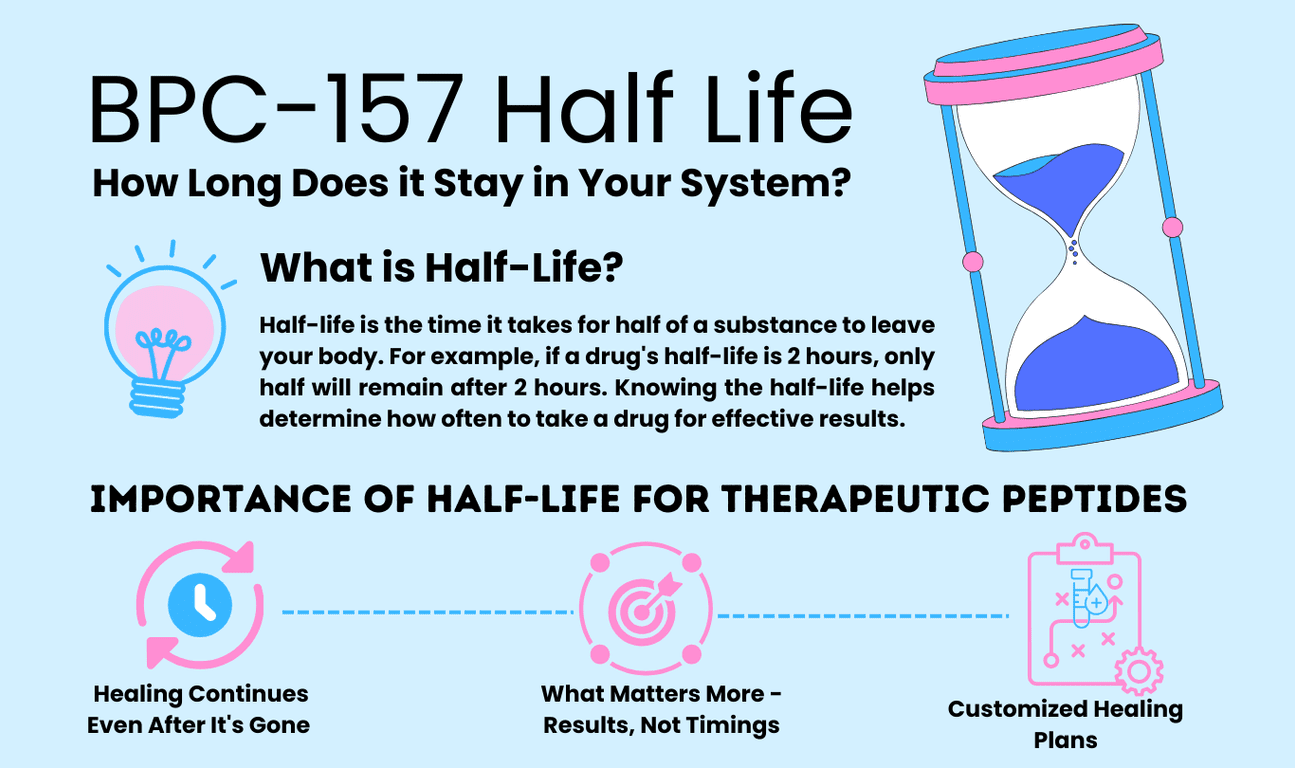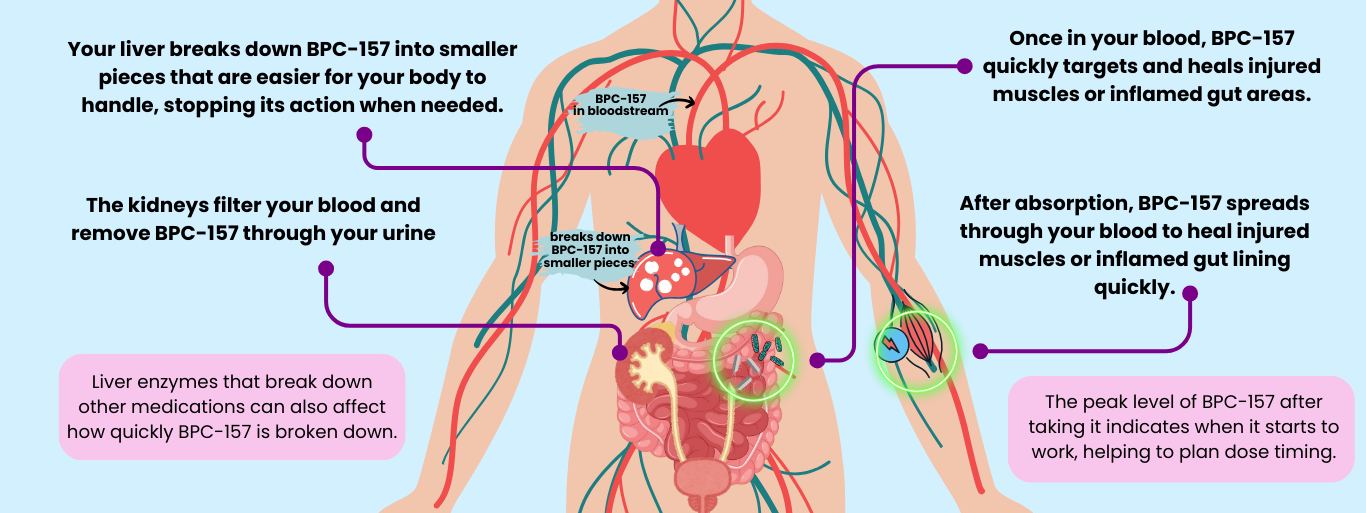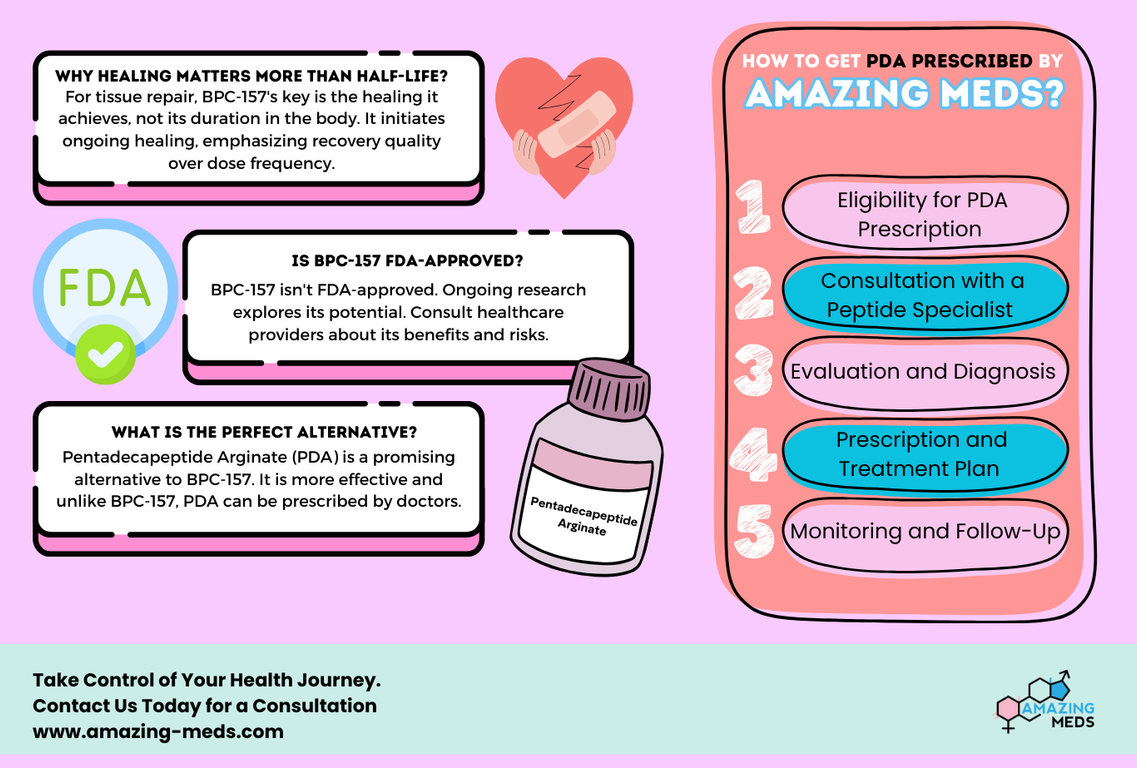Peptides are small chains of amino acids that help the body heal. BPC-157 is a peptide that can speed up recovery from injuries and improve gut health.[1] One important aspect to know about BPC-157 is its half-life—how long it stays active in your body. This page will explain what half-life means, why it’s important, and how it relates to BPC-157.
What is Half-Life?
Half-life is the time it takes for half of a substance to leave your body. For example, if a drug has a half-life of 2 hours, only half of it will be left in your system after 2 hours. Knowing the half-life helps you figure out how often to take a drug to keep it working well.
Why Half-Life is Important for Therapeutic Peptides
When using treatments like BPC-157 that help repair tissues and speed up healing, knowing how long it stays in your body is important. However, the real benefit of BPC-157 lies in how well it helps your body heal, not just how long it stays in your system.
1. Healing Continues Even After It’s Gone
BPC-157 helps start healing processes that continue even after the peptide is gone. It helps blood vessels grow and tendons heal, which keeps improving your body.
2. What Matters More – Results, Not Timings
BPC-157 is highly effective at initiating healing processes quickly. This allows medical professionals to tailor treatment plans with precision, ensuring optimal results without long-term side effects.
3. Customized Healing Plans
BPC-157 can be taken as an injection or a pill, making it easy to fit into your treatment plan.
Factors That Influence BPC-157’s Half-Life
Mode of Administration (Injection vs. Oral)
Injecting BPC-157 goes directly into your blood, making it work faster and last longer. Taking it as a pill means it first goes through your stomach and breaks down quicker.
Dosage
The amount of BPC-157 you take at one time can affect how long it stays in your system. Higher doses might last longer but can also have more side effects.
Individual Differences (Age, Weight, Health Status)
Everyone’s body is different. Older adults or people with health problems might process BPC-157 more slowly, affecting how long it stays in the body.
Interaction with Other Drugs or Substances
The medications you take can make BPC-157 work faster or slower, affecting how long it lasts. For example, certain pain relievers or supplements might speed up the liver’s processing of peptides, reducing the half-life of BPC-157.
Half-Life of BPC-157 in Different Administration Routes
It’s often suggested that BPC-157 effects could last about six hours after taking it. How you take it can influence how long it stays active:
Oral Administration
Swallowing BPC-157 may not last long because stomach acids break it down quickly. This method might need more frequent dosing.
Subcutaneous Injection (Injection Under the Skin)
An injection just under the skin releases BPC-157 slowly into your blood, helping it last longer.
Intramuscular Injection (Injection Into a Muscle)
This method leads to faster absorption with a shorter half-life but quicker effects.
Absorption and Distribution of BPC-157
How BPC-157 is Absorbed into the Bloodstream
Once in your blood, BPC-157 quickly targets and begins to heal injured areas like muscles or inflamed parts of your gut. It attaches to specific spots on cells that need repair.
Distribution Patterns in the Body
After absorption, BPC-157 spreads through your blood, reaching areas that need healing, such as injured muscles or inflamed gut lining. This helps it start the healing process quickly.
Initial Peak Concentrations and Their Implications
The highest level of BPC-157 right after taking it shows when it might start to have an effect. This helps plan the best timing for doses.
Metabolism of BPC-157
Primary Metabolic Pathways for BPC-157
Your liver breaks down BPC-157 into smaller pieces that are easier for your body to handle, stopping its action when needed.[3]
Enzymatic Interactions Influencing Breakdown
Certain enzymes in your liver, which also break down other medications, can speed up or slow down how quickly BPC-157 is broken down.
Excretion of BPC-157
Routes of BPC-157 Elimination (Renal, Hepatic)
Your kidneys and liver remove BPC-157 from your body. The kidneys filter your blood and remove BPC-157 through your urine.[2] The liver also breaks down the peptide before it reaches your kidneys.
Impact of Renal or Liver Function on Excretion Rates
If your kidneys or liver aren’t working well, it can affect how long BPC-157 stays in your body. For example, if your kidneys aren’t in good shape, BPC-157 might build up in your body, so you might need to adjust the dose to prevent harm.
Clinical Implications of BPC-157 Half-Life
Understanding the half-life of BPC-157 is essential for effective treatment planning. It informs the timing and frequency of doses to ensure continuous therapeutic benefits. This knowledge allows healthcare providers to tailor treatment plans to individual needs, maximizing the healing potential of BPC-157.
Why Healing Factors Are More Important Than Half-Life
When using BPC-157 for tissue repair and recovery, the most important thing isn’t how long the treatment stays in the body, but rather the healing it achieves. BPC-157 starts healing processes that continue to provide benefits long after the peptide has left the bloodstream. What matters is the quality of recovery it supports, not the frequency of doses.
Is BPC-157 FDA-Approved? Are There Viable Alternatives?
Legal FDA Stance on BPC-157
Currently, BPC-157 has not received FDA approval. However, ongoing research continues to investigate its therapeutic potential. It’s important for users to consult with healthcare providers to understand both the benefits and any potential risks associated with its use.[4]
Pentadecapeptide Arginate (PDA): The Perfect Alternative
There’s a really promising alternative to BPC-157 that’s available. It’s called Pentadecapeptide Arginate, or simply PDA. Like BPC-157, it’s made up of 15 amino acids, the small building blocks our bodies use to function. What sets PDA apart is that it contains an extra ingredient called arginate, which helps it stay effective in the body for a longer period.
PDA works wonders for healing and repairing damaged tissues, just like BPC-157. It’s especially great at speeding up wound healing, reducing swelling, and improving the health of blood vessels, which is crucial for overall well-being.
The main difference is that PDA is allowed to be prescribed by doctors for treatment, whereas BPC-157 hasn’t received the same approval.
How to Get PDA Prescribed by Amazing Meds
1. Eligibility for PDA Prescription
If you’
re considering PDA, the first step is figuring out if it’s right for you. You need a medical reason that PDA could help with, like a slow-healing injury or other health issues.
2. Consultation with a Peptide Specialist
Next, you’ll talk to one of our medical experts at Amazing Meds who specializes in peptides. You can schedule a consultation through our clinic or our telemedicine service. Our specialists will review your health history and current needs to see if PDA could be a good fit for you.
3. Evaluation and Diagnosis
During the consultation, we will gather detailed information about your symptoms, health status, medical conditions, and any previous treatments or medications you’ve tried. This helps them decide if PDA could benefit you.
4. Prescription and Treatment Plan
If you and your specialist decide that PDA is right for you, we will set up a treatment plan. This includes the specific PDA dosage, how you will take it (injections, oral, etc.), how often you should take it, and how long the therapy will last.
5. Monitoring and Follow-Up
Once you start treatment, you’ll have regular check-ins with your specialist. We’ll make sure the PDA is helping and not causing any problems. It’s important to monitor your progress and adjust the treatment if necessary to get the best results.
Frequently Asked Questions
What is BPC-157?
BPC-157 is a peptide, which is a small chain of amino acids. It is made from a protein found in the stomach and is studied for its healing properties. It helps heal various tissues, including skin, muscle, bone, and the inner lining of the gut.
How is BPC-157 administered?
BPC-157 can be taken in different ways, depending on what you need and what you prefer. The most common methods are injections under the skin, injections into the muscle, and taking it by mouth.
What is the half-life of BPC-157?
The half-life of BPC-157 can vary based on how you take it, but it generally lasts a few hours. This means it stays active in the body for a short time, so you might need to take it often to keep it working.
Why is the half-life of a drug important?
The half-life of a drug is important because it tells you how often you need to take it to keep it working well. Understanding the half-life helps you schedule doses to get the best effect while avoiding side effects.
Does the route of administration affect BPC-157’s half-life?
Yes, how you take BPC-157 affects its half-life. Taking it by mouth usually means it breaks down and leaves your body faster, while injections can make it last longer in your system.
What factors influence how long BPC-157 stays in your system?
Several things can affect how long BPC-157 stays in your body, including the dose, how you take it, your metabolism, liver and kidney function, age, weight, and health status. Other medications can also speed up or slow down how fast BPC-157 leaves your body.
Can the half-life of BPC-157 vary between individuals?
Yes, the half-life of BPC-157 can vary between people because everyone’s body works differently. Younger people with faster metabolisms might process it quicker than older adults.
How does body weight affect the dosing of BPC-157?
Body weight can significantly impact the dosing of BPC-157. Generally, larger individuals may require higher doses to achieve the same therapeutic effects seen in smaller individuals. This is due to differences in body mass and blood volume.
Is there a risk of overdose with BPC-157?
Yes, there is a potential risk of overdose with BPC-157, especially if taken without proper medical supervision. Symptoms of overdose can vary depending on the amount taken and the method of administration. It’s important to follow dosing recommendations carefully and consult with a healthcare provider.
How is BPC-157 metabolized in the body?
BPC-157 is primarily metabolized in the liver. The liver breaks it down into smaller fragments that can be more easily eliminated from the body. This process is essential for regulating the duration and intensity of its therapeutic effects.
What are the primary pathways for BPC-157 elimination?
The primary pathways for the elimination of BPC-157 are through the kidneys (renal) and the liver (hepatic). The kidneys filter out waste and excess substances from the blood, including metabolized fragments of BPC-157, which are then excreted in the urine. The liver also plays a crucial role in breaking down the peptide before it reaches the kidneys.
Can BPC-157 interact with other medications?
Yes, BPC-157 can interact with other medications, particularly those that affect blood clotting or the immune response. It’s important to discuss all medications and supplements you are taking with your healthcare provider before starting BPC-157 to avoid potential interactions.
Can BPC-157 be used in conjunction with other therapies?
BPC-157 can often be used alongside other therapies, especially for injury repair and healing. It may complement physical therapy, nutritional support, and other medications by enhancing the healing process.
Is BPC-157 FDA-approved?
Currently, BPC-157 has not been approved by the FDA. This doesn’t mean it’s unsafe or ineffective, but it hasn’t passed all the rigorous tests needed for official approval for widespread use. The FDA has also stated that there’s no legal ground for pharmacies to include BPC-157 in custom-made medications.
What is Pentadecapeptide Arginate (PDA)?
Pentadecapeptide Arginate, or PDA, is another type of peptide, designed to be similar to BPC-157 but with some changes intended to meet the safety and effectiveness standards set by the FDA. It’s made up of 15 amino acids and includes an extra ingredient called arginate salt, which helps it stay effective in the body for a longer period.
Why is PDA a viable alternative to BPC-157?
PDA is a viable alternative to BPC-157 because it can be legally prescribed and has been through the necessary regulatory processes to ensure its safety and effectiveness. This makes it a safer option for patients looking for similar benefits to BPC-157 but with regulatory approval.
Does Amazing Meds offer doctor-prescribed PDA?
Yes, at Amazing Meds, we offer doctor-prescribed PDA. We work with medical professionals to ensure that every prescription is tailored to meet the specific health needs of our patients, following all medical guidelines.
Can I get access to Amazing Meds PDA therapy nationwide?
Absolutely. One of the great benefits of Amazing Meds is our ability to provide PDA and other specialized peptide therapies via nationwide telemedicine consultations and treatment. No matter where you live in the U.S., you can schedule an online consultation with our medical team to discuss your case and potentially get prescribed a customized PDA therapy plan.
How can I contact Amazing Meds to discuss PDA and other peptide therapy options?
You can contact Amazing Meds to discuss peptide therapy options by visiting our website or contacting our office our office directly. We offer both in-person and telehealth consultations, making it convenient for you to reach out and get the information you need about our peptide therapy services from anywhere in the USA.
Final Words on BPC-157’s Half Life
BPC-157 is a powerful peptide with many healing benefits, from repairing tissues and reducing inflammation to improving gut health. Understanding its half-life is important, but the primary focus should be on its remarkable healing properties and how it can be used effectively. Whether you’re an athlete recovering from an injury or dealing with chronic pain or digestive issues, BPC-157 offers significant therapeutic potential.
For more personalized information on how BPC-157 can help you, and to exp
lore the option of PDA as an alternative, consult with a healthcare provider or a peptide specialist. At Amazing Meds, our experts can help you develop a treatment plan that fits your specific needs and health goals. Contact us today to schedule a consultation and take the first step towards enhanced healing and recovery.
Contact Amazing Meds
Visit our website or call our office directly to discuss your options and get started with our peptide therapy services. We offer both in-person and telehealth consultations, making it convenient for you to get the information you need from anywhere in the USA.
How Long Does BPC-157 Stay in Your System? – A Visual Summary
References
- Seiwerth S, Rucman R, Turkovic B, Sever M, Klicek R, Radic B, Drmic D, Stupnisek M, Misic M, Vuletic LB, Pavlov KH, Barisic I, Kokot A, Japjec M, Blagaic AB, Tvrdeic A, Rokotov DS, Vrcic H, Staresinic M, Sebecic B, Sikiric P. BPC 157 and Standard Angiogenic Growth Factors. Gastrointestinal Tract Healing, Lessons from Tendon, Ligament, Muscle and Bone Healing. Curr Pharm Des. 2018;24(18):1972-1989. doi: 10.2174/1381612824666180712110447. PMID: 29998800.
- He L, Feng D, Guo H, Zhou Y, Li Z, Zhang K, Zhang W, Wang S, Wang Z, Hao Q, Zhang C, Gao Y, Gu J, Zhang Y, Li W, Li M. Pharmacokinetics, distribution, metabolism, and excretion of body-protective compound 157, a potential drug for treating various wounds, in rats and dogs. Front Pharmacol. 2022 Dec 14;13:1026182. doi: 10.3389/fphar.2022.1026182. PMID: 36588717; PMCID: PMC9794587.
- He, Lei & Feng, Donglin & Guo, Hui & Zhou, Yueyuan & Li, Zhaozhao & Zhang, Kuo & Zhang, Wangqian & Wang, Shuning & Wang, Zhaowei & Hao, Qiang & Zhang, Cun & Gao, Yuan & Gu, Jintao & Zhang, Yingqi & li, Weina & Li, Meng. (2022). Pharmacokinetics, distribution, metabolism, and excretion of body-protective compound 157, a potential drug for treating various wounds, in rats and dogs. Frontiers in Pharmacology. 13. 1026182. 10.3389/fphar.2022.1026182.
- U.S. Food and Drug Administration. (2023). Safety Risks Associated with Certain Bulk Drug Substances Nominated for Use in Compounding.





